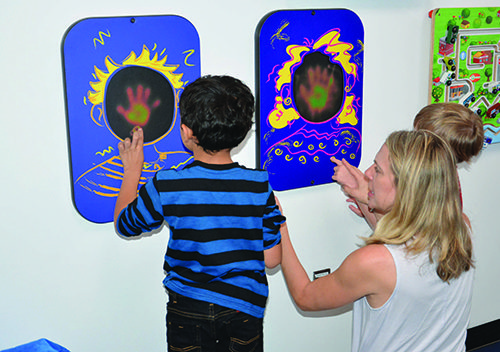Winding through busy terminals, waiting in security lines and enduring flight delays are just a few stressful facts of life for air travelers. Imagine, however, navigating these challenges while traveling with a child who has autism and is extremely sensitive to sights, sounds and physical touch.
Winding through busy terminals, waiting in security lines and enduring flight delays are just a few stressful facts of life for air travelers. Imagine, however, navigating these challenges while traveling with a child who has autism and is extremely sensitive to sights, sounds and physical touch.
Or how about ushering two children with autism into a crowded holdroom as a swarm of irritated arriving passengers sprint to catch their connecting flights? (One large study notes that nearly 20% of families affected by autism have more than one child with the disorder.)
The bustling crowds, bright displays, overlapping audio announcements and sweeping architecture in airports can easily overwhelm children with autism. One of the first steps in their journey—passing through a TSA checkpoint—is a process some simply don’t understand. A requirement that is tedious for other travelers can prove extremely upsetting for children with autism.
|
Project: Multi-Sensory Room Location: Miami Int’l Airport—North Terminal, Concourse D Strategy: Provide private space to help ease travel stresses for children with autism & other cognitive or developmental disabilities Room Features: Dim lighting; aquatic bubble tube; wall puzzles; soft, cushioned seats; light projector Project Cost: $22,650 Funding: $15,000 from donors, partnerships & Miami Beat Team contributions; $7,650 from Miami-Dade Aviation Dept. Partners: University of Miami-Nova Southeastern Center for Autism & Related Disabilities; Miami Beat Team Umbrella Program: MIA Instruction & Readiness (MIAair), which helps travelers with special needs practice navigating the airport before their actual travel dates |
Many common travel stressors are multiplied exponentially for such families. Sometimes, the challenges are so difficult, they avoid flying whenever possible.
Miami International Airport (MIA) recently took action to help. In April, it celebrated Autism Awareness Month by unveiling a multi-sensory room to make travel easier for young passengers with cognitive or developmental disabilities. The space is dimly lit, with sensory-soothing features such as an aquatic bubble tube, interactive wall puzzles, beanbag seating and a light projector that creates moving images on a wall.
Located just beyond security checkpoint No. 4 in Concourse D, the room is open seven days a week from 6 a.m. to 10 p.m. The airport uses signage and a local marketing campaign to help spread the word about its new retreat.
Local Support
MIA worked with the University of Miami-Nova Southeastern Center for Autism and Related Disabilities to design the room’s soothing features. The organization also educated airport staff and provided information that helped get the project greenlighted.
“For people with autism, preparation for what they’re going to experience is one of the best things that help,” explains Diane Adreon, the center’s associate director. “It’s great for our community to become more sensitive and provide support for people with autism. Airline travel, like anything that is outside of their routine, can be difficult to handle.”
The project also was completed in coordination with the Miami Beat Team, a group of 15 local business professionals who assist with community service projects. Among other things, the group coordinated fundraising that provided $15,000 for the project. The remaining $7,650 came from the Miami-Dade Aviation Department.
Three Aviation Department employees who are on the Beat Team spearheaded the multi-sensory room project as an expansion of MIA Instruction & Readiness (MIAair), the airport’s support program for passengers with special needs. Launched in 2015, MIAair provides educational materials and opportunities for passengers with special needs to practice crucial aspects of the travel experience (navigating the terminal, passing through a security checkpoint, boarding a plane, etc.) before their actual travel dates.

Growing Need
One reason MIA and other airports are making such efforts is an increase in the number of children being diagnosed with autism. In the United States alone, one in 59 children has an autism spectrum disorder, according to a 2018 report from the Centers for Disease Control and Prevention. That’s up from one in 68 children just two years earlier. And many, including Adreon, say that statistics understate the issue, because there are more children on the spectrum who have not been diagnosed.
 “Multi-sensory rooms have proven to be a helpful amenity for traveling families at other airports, and MIA wants to be on the forefront of accommodating the needs of all travelers,” says Lester Sola, MIA director and chief executive officer. “Early feedback from users of the multi-sensory room has been overwhelmingly positive, with parents telling us how thankful they are that the airport has provided a quiet, private space for their children to de-stress and prepare for the next step in their airport experience.”
“Multi-sensory rooms have proven to be a helpful amenity for traveling families at other airports, and MIA wants to be on the forefront of accommodating the needs of all travelers,” says Lester Sola, MIA director and chief executive officer. “Early feedback from users of the multi-sensory room has been overwhelmingly positive, with parents telling us how thankful they are that the airport has provided a quiet, private space for their children to de-stress and prepare for the next step in their airport experience.”
Airport officials are consequently exploring the possibility of opening a second multi-sensory room in MIA’s South Terminal. Multi-sensory rooms can also benefit children and adults with cerebral palsy, intellectual disabilities, brain injuries, dementia and mental health issues such as stress or anxiety.
For Sola, it’s all about inclusivity and providing travel opportunities to families that may otherwise be hesitant to fly: “The goal of the MIAair program is for everyone to experience the magic and wonder of flight.”
|
More Work to Be Done Miami International is reportedly one of only eight airports in the world with a private lounge for travelers with autism and other sensory disorders. But if Tanya Acosta has her way, more airports will add facilities for passengers who are extra sensitive to the cacophony common in all terminals.
Acosta’s nonprofit organization provides staff training and facility design support to help airports make their terminals more accessible and inclusive for customers with sensory needs. Inclusive bathrooms, for instance, don’t have loud hand dryers or toilets that flush automatically. Staff training can demonstrate the differences between tantrums and sensory overload—and teach airport employees how to help de-escalate a sensory meltdown. “Sensory overload affects the person having it and everyone around them—their family members, other passengers and airport employees,” advises Acosta. “We want to promote awareness and provide education to make it better for everyone.” Staff training from Sensory City costs $50 per person, or a flat fee of $1,800 to $2,500 for groups of 50 or more. The price for facility design is quoted on a case-by-case basis because it varies widely, but free consultations are provided. The nonprofit organization also sells kits that include weighted lap pads, noise-cancelling headphones, therapeutic toys and other items to make airports more comfortable for travelers with sensory challenges. Beyond leveraging the products and services offered by Sensory City, Acosta encourages airports to tell their customers about TSA’s passenger assistance program. “They don’t do a great job publicizing it, but it can really help customers with special needs get through the security checkpoint.” In addition to her academic and professional credentials, Acosta also brings an insider’s perspective to the subject as the mother of a young child with Down syndrome and daughter of a parent with Alzheimer’s disease. She recounts one particularly difficult trip when her mother was in the throes of dementia: “She was kicking and punching because she was scared and confused. She didn’t know where she was, and sometimes didn’t know who I was. She took food off someone else’s plate in the restaurant, spit on the floor and screamed on the way to the gate. Scenes like that can look weird or dangerous to others; but caregivers need understanding and help, not judgment or rude comments.” Difficulties notwithstanding, Acosta loves to travel with her family and is passionate about making travel less complicated for families like hers. She applauds the 38 U.S. and Canadian airports with programs that help passengers practice the travel process, and urges the entire industry to take the next logical step: making facilities more accessible and inclusive. To view a two-minute video that portrays sensory overload, visit www.sensorycity.org. |


 facts&figures
facts&figures
 As founder and executive director of Sensory City, Acosta is working to make a variety of facilities more accessible for children and adults with autism, attention deficit/hyperactivity disorder, dementia, post-traumatic stress disorder and related conditions. “People understand what a wheelchair or white cane with a red tip means, but most don’t know what sensory disorders look like,” she explains. “They’re much less visible disabilities.”
As founder and executive director of Sensory City, Acosta is working to make a variety of facilities more accessible for children and adults with autism, attention deficit/hyperactivity disorder, dementia, post-traumatic stress disorder and related conditions. “People understand what a wheelchair or white cane with a red tip means, but most don’t know what sensory disorders look like,” she explains. “They’re much less visible disabilities.”

